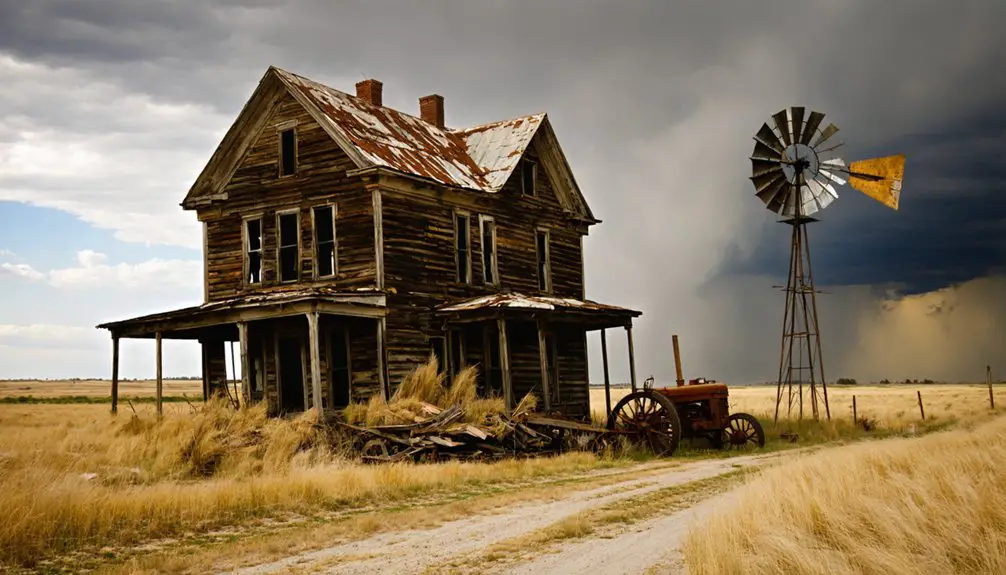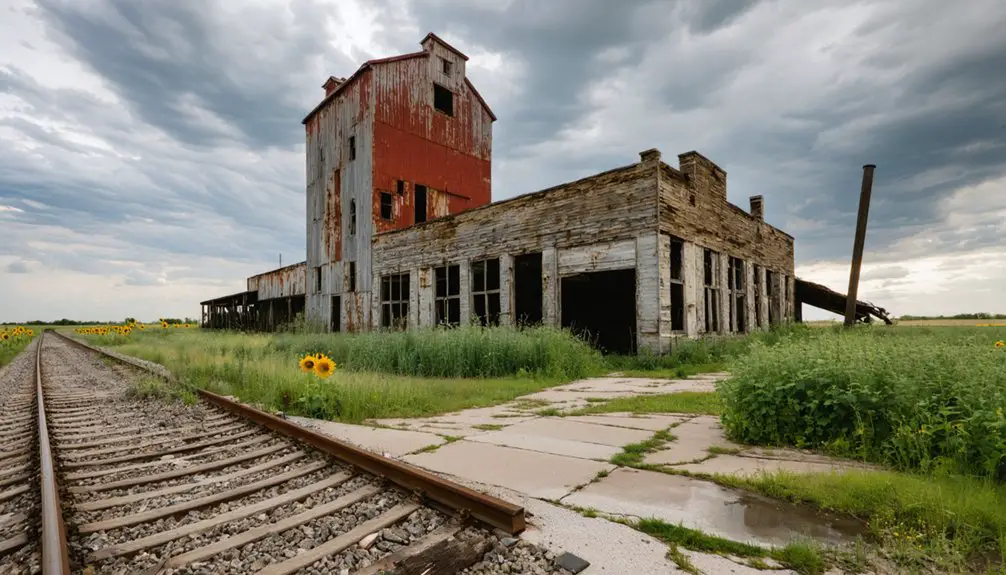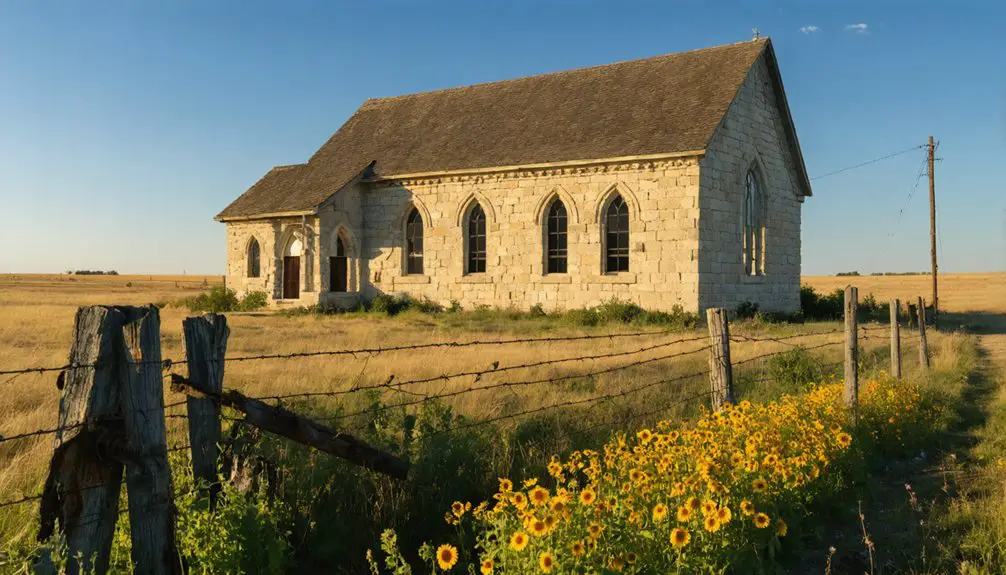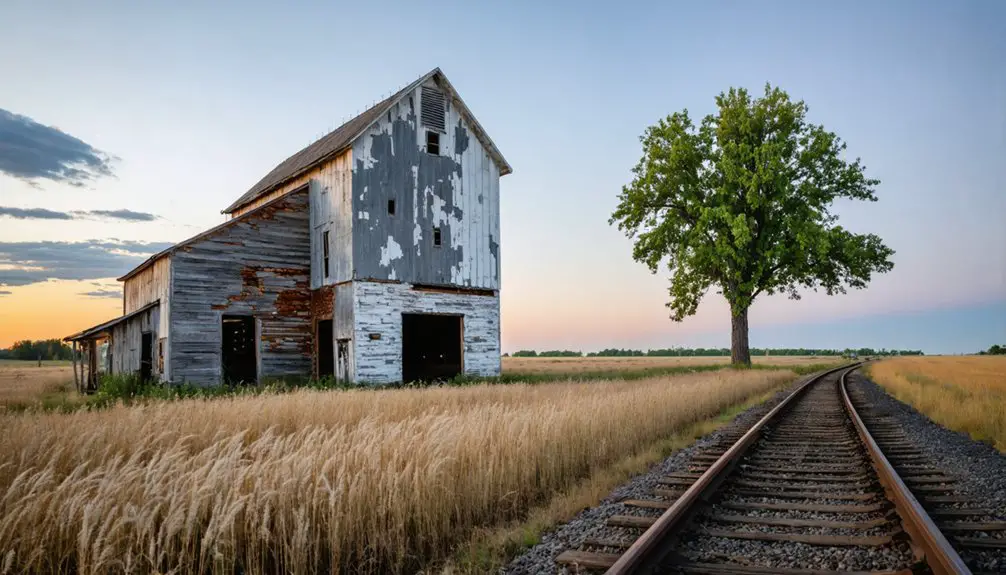You’ll find Bala’s ghost town in Riley County, Kansas, where Welsh pioneers established Y Bala yn Powys in 1871. The community thrived through the late 1800s with its Welsh Congregational Church, cheese factory, and tight-knit population of 23 Welsh natives. Natural disasters, including a devastating 1903 tornado, and the Great Depression led to its decline. Today, you can explore remnants like the stone arch railroad bridge while uncovering a rich story of Welsh-American heritage.
Key Takeaways
- Bala, Kansas was established in 1871 by Welsh settlers but declined after the Kansas Central Railway bypassed the town in 1881.
- A devastating 1903 tornado and the Great Depression caused significant population loss, with over half the residents leaving during the 1930s.
- The town’s final decline occurred when its post office closed in 1966, leaving the original town center largely abandoned.
- Today, fewer than 30 residents live near Bala’s old townsite, with only scattered dilapidated houses marking the former community.
- The historic stone arch railroad bridge and Bala Heritage Park remain as the primary physical remnants of the once-thriving Welsh settlement.
Welsh Pioneers and Early Settlement
While many immigrant groups settled across Kansas during the 19th century, Welsh pioneers specifically chose Bala as their new home beginning in spring 1862 with A.D. Phelps. Driven from their homeland by Tory landlords’ evictions, these determined settlers found hope in Kansas’s fertile plains.
In March 1870, Reverend R. Gwesyn Jones and James Hughes Jenkins purchased land at $2.50 per acre from the Kansas Pacific Railroad Company. They established Y Bala yn Powys, named after their beloved town in North Wales. The town was later laid out in 1871 when settlers relocated to find a more reliable water source. The community quickly grew to include a cheese factory and blacksmith, serving the needs of local residents.
Despite settlement challenges, including droughts and complex land ownership issues, the Welsh pioneers maintained their traditions. By the 1870 census, 23 Welsh natives had created a tight-knit community, preserving their language and customs while building new lives in Riley County’s promising landscape.
Life in Y Bala Yn Powys
In Y Bala yn Powys, you’d find Welsh settlers maintaining their native language through daily interactions, church services, and community gatherings along Timber Creek.
Your fellow colonists spent their days working the $2.50-per-acre farmland purchased from the Kansas Pacific Railroad Company, adapting traditional Welsh agricultural methods to the Kansas prairie. The community preserved their Hungarian-language text alongside Welsh traditions, creating a multilingual settlement. The settlers drew inspiration from religious leaders like Simon Lloyd, who had championed Methodist teachings back in Wales.
You’d regularly join other settlers at the Welsh Congregational Church, which served as both a spiritual center and community hub where religious services, social events, and cultural celebrations reinforced the bond among immigrant families.
Welsh Language Preservation
Through religious reformation and cultural resilience, the Welsh language thrived in Y Bala yn Powys during the 16th century and beyond.
You’ll find that the 1563 Act of Parliament played a significant role, mandating Welsh translations of the Bible and allowing church services in the native tongue. This preserved the cultural identity when Welsh lost its status as a high culture language in the 17th century.
In homes, workplaces, and places of worship across Y Bala, Welsh remained dominant well into the 19th century. Local dialects flourished, rich with peasant lore and regional variations. The Methodist Revival movement significantly strengthened Welsh language preservation through education and religious practice. Today, about 538,300 Welsh speakers remain in Wales, continuing this linguistic heritage.
The community’s dedication to language preservation showed through their participation in eisteddfod festivals, where poetry and music competitions kept Welsh traditions alive.
Religious organizations and the printing press supported Welsh texts, ensuring the language’s importance for future generations.
Farming and Daily Life
Life in Y Bala yn Powys centered on farming and livestock raising, with settlers paying $2.50 per acre to the Kansas Pacific Railroad Company for their farmland.
You’d find settlers adapting their crop rotation and livestock management practices to the challenging Kansas environment, especially dealing with water scarcity that forced the community to relocate near a reliable spring.
Daily operations revolved around dairy production, with the local cheese factory processing milk into exportable cheese.
Your success depended on maintaining strong trade routes through Clay Center to reach larger markets.
While tending to livestock and crops, you’d also rely on community members like James Hughes Jenkins, who provided essential services through his roles as notary public, insurance seller, and bank operator.
The settlers’ resilience showed in their ability to diversify both agricultural and commercial ventures, similar to the enduring spirit found in nearby Cedar Point mill, which still stands today.
A devastating tornado in 1882 struck the farming community, causing significant damage to crops and buildings.
Church Community Activities
Religious institutions formed the cornerstone of Y Bala yn Powys‘s social fabric after 1890, when the Presbyterian Church emerged as the settlement’s primary gathering place.
You’d find a vibrant mix of Welsh traditions preserved through church events and community gatherings, where settlers maintained their cultural identity while adapting to life in Kansas.
- Welsh Calvinist, English Methodist Episcopal, and Congregational churches served diverse ethnic groups
- Church buildings doubled as educational centers, offering both English and Welsh language instruction
- Reverend R. Gwesyn Jones led Welsh cultural preservation through religious services and social activities
The churches provided more than spiritual guidance – they created support networks for newcomers, helped organize civic improvements, and offered gathering spaces where you could connect with neighbors during festivals, meetings, and times of hardship.
Today, only an abandoned stone church remains as a silent reminder of Bala’s once-thriving religious community.
Cultural Heritage and Community Bonds
When Welsh settlers established Bala, Kansas, they created more than just a frontier town – they built a tight-knit cultural enclave that preserved their heritage through intentional community bonds.
You’ll find their cultural identity woven into every aspect of the settlement, from naming the town after Y Bala yn Powys to maintaining Welsh language use in daily life and church gatherings.
Community resilience emerged through shared challenges and cooperative problem-solving. Leaders like Reverend R. Gwesyn Jones and James Hughes Jenkins strengthened organizational cohesion while providing essential services. Similar to the town’s two churches in Minersville, these institutions helped unite residents through difficult times.
When water shortages threatened the town’s survival, the community worked together to relocate closer to a spring.
Through their schools, church activities, and social institutions, Bala’s residents maintained strong connections to their Welsh roots while adapting to frontier life.
Natural Disasters and Economic Hardships

If you’d visited Bala in 1903, you’d have witnessed the devastating tornado that marked the beginning of the town’s decline, destroying critical infrastructure and displacing many residents.
The community’s challenges intensified during the Great Depression (1929-1939), when more than half of Bala’s population left due to severe economic hardship and farming difficulties.
Your journey to Bala today reveals the lasting impact of these setbacks, as the town’s early settlers also struggled with insufficient water supplies and failed coal mining ventures near their original settlement.
Devastating 1903 Tornado Impact
A devastating tornado struck the small settlement of Bala, Kansas in May 1903, killing two children and marking the beginning of a tumultuous period for the community.
The tornado’s aftermath severely impacted Bala’s infrastructure and tested the community’s resilience during an already challenging year of natural disasters in Riley County.
- The storm destroyed critical buildings and housing, limiting local business operations.
- Combined with severe flooding, the tornado damaged essential transportation routes and bridges.
- Economic recovery efforts were hindered by recurring weather hazards in the region.
Great Depression Population Loss
The Great Depression dealt another severe blow to Bala’s already weakened community in the years following the 1903 tornado. The town’s population decline accelerated as economic struggles forced many residents to seek opportunities elsewhere.
You’ll find that the discontinuation of the Bala City depot during this period severely impacted the town’s trade and travel capabilities.
Making matters worse, the construction of new hard surface county roads bypassed both Bala and Bala City entirely, cutting off essential transportation links.
With little investment in local infrastructure and diminishing economic prospects, the town’s isolation deepened. The combined effects of these hardships meant that by the time the Great Depression ended, Bala’s community had been fundamentally altered, setting the stage for its eventual transformation into a ghost town.
Weather and Agricultural Challenges
Since Bala’s early settlement days, extreme weather fluctuations have posed significant challenges for local farmers and residents. You’ll find that Kansas’s climate impacts hit this region particularly hard, with temperatures swinging from a scorching 121°F to a brutal -40°F.
The area’s drought resilience was severely tested during the 1930s Dust Bowl, when devastating soil erosion and crop failures forced many to abandon their farms.
- Annual rainfall variability between 15-40 inches created unpredictable growing conditions
- Lengthening freeze-free seasons altered traditional planting schedules
- Recent weather patterns since 2015 brought increased flooding risks
The economic toll of these weather extremes continues to shape the region’s agricultural landscape. Farmers who remained faced mounting challenges from shifting precipitation patterns, increased pest pressures, and rising adaptation costs for irrigation infrastructure.
The Town’s Physical Evolution

Located at a spring-adjacent site two miles west of its original position, Bala’s physical evolution began when Welsh settlers relocated their community in 1871 due to water scarcity at Timber Creek fork.
The town layout initially featured two city blocks of houses south of a church, with a post office serving as an essential community hub until 1966.
You’ll find few structural remnants of Bala’s once-bustling settlement today. The old church off the main road stands as the most notable survivor, while scattered occupied homes preserve minimal traces of the original community.
The downtown area has vanished entirely, and accessing the site requires maneuvering around Bala Road via Jenkins Road. A devastating 1903 tornado permanently altered the town’s physical landscape, contributing to its gradual transformation into a ghost town.
Railroad Influence and Land Development
Railroad development proved transformative for Bala’s trajectory when the Kansas Central Railway bypassed the town in 1881, choosing instead to route through nearby Leonardville. This decision triggered a chain of events that reshaped the local railroad economics and forced town relocation to survive.
The railroad’s influence on Bala’s development became evident through:
- The establishment of Bala City station 1.5 miles southwest in 1887
- A mass exodus of businesses and residents toward the new Chicago and Rock Island Railroad tracks
- The naming of Leonardville after railroad president Leonard T. Smith, showing corporate influence
You’ll find that Bala’s story reflects a common pattern in Kansas, where railroad companies wielded enormous power through land grants and strategic routing decisions, effectively determining which towns would thrive and which would fade into obscurity.
Preservation of Historical Artifacts

While the railroad’s influence led to Bala’s decline, dedicated preservation efforts have worked to protect the town’s rich Welsh heritage and historical remnants.
You’ll find careful historical documentation through the Kansas Historical Society, which maintains land deeds, census records, and photographs of key structures like the Presbyterian Church ruins and stone railroad bridge.
The Bala Heritage Park stands as a tribute to artifact conservation, featuring one of Kansas’s largest stone arch bridges.
While natural elements and Fort Riley’s expansion have challenged preservation efforts, you can still explore the cultural legacy through oral histories and archived personal accounts from Welsh settler descendants.
Local historical societies continue their crucial work of safeguarding records, though the lack of residents makes ongoing site preservation difficult.
Modern Day Ghost Town Status
Today, fewer than 30 residents inhabit the immediate area of Bala’s old townsite, marking its status as one of Kansas’s many ghost towns.
Like many Kansas ghost towns, Bala’s historic heart beats faintly, with barely 30 souls remaining in its original townsite.
While the broader Bala township counts 669 residents as of 2025, the original town center stands largely abandoned, with only a few rugged houses and the deteriorating Presbyterian Church remaining as silent witnesses to its past.
You’ll find these remnants of Bala’s former significance:
- A historic stone arched railroad bridge at Bala Heritage Park
- Scattered dilapidated houses showing decades of neglect
- The weathered Presbyterian Church structure
Located 25 miles northwest of Manhattan, Bala’s ghost town tourism potential remains untapped, though the community’s resilience shows in the handful of determined residents who’ve chosen to stay despite the town’s decline and Fort Riley’s expansion.
Frequently Asked Questions
Were There Any Native American Encounters With Bala’s Welsh Settlers?
You won’t find documented Native encounters or cultural exchanges between Bala’s Welsh settlers and indigenous peoples, as most Native Americans had been displaced from eastern Kansas before the settlement’s 1870 establishment.
What Happened to the Descendants of Bala’s Original Welsh Families?
You’ll find their family legacies scattered across Kansas, Pennsylvania, and western states, as descendants left for better opportunities, gradually losing their Welsh cultural heritage through assimilation into broader American communities.
Did Bala Have Any Significant Criminal Activity During Its Peak Years?
You won’t find records of significant criminal incidents or law enforcement problems in Bala during its peak. The Welsh immigrant community maintained a peaceful, orderly settlement focused on cultural preservation and cooperation.
What Crops Did Welsh Farmers Primarily Grow in Bala’s Agricultural Heyday?
You’ll find that Welsh agriculture in Bala centered primarily on wheat cultivation, especially Turkey Red wheat, with corn as a secondary crop. Farmers practiced crop rotation and maintained vegetable gardens for local consumption.
Were There Any Famous Visitors or Notable Events in Bala’s History?
You won’t find many famous visitors in Bala’s records, though Reverend R. Gwesyn Jones and James Hughes Jenkins were notable Welsh leaders. The most significant event was a devastating 1903 tornado.
References
- https://legendsofkansas.com/bala-kansas/
- https://welshhistories.co.uk/bala-kansas-a-welsh-ghost-town-that-will-remind-you-of-a-painful-past/
- https://www.ghosttowns.com/states/ks/bala.html
- https://www.legendsofamerica.com/ks-ghosttowns/
- https://www.rileycountyks.gov/441/History-of-Riley-County
- https://nawalesfoundation.org/welsh-in-america.html
- https://www.kancoll.org/khq/1977/77_4_davies.htm
- https://lostkansas.ccrsdigitalprojects.com/sites/lostkansas/files/private_static/2023-07/KHAL_RL-LY-GE_HenWladFyNhadauLandOfMyFathers_Jones (2).pdf
- https://en.wikipedia.org/wiki/Bala
- https://eryri.gov.wales/wp-content/uploads/2022/09/4-Bala-CMP.pdf



